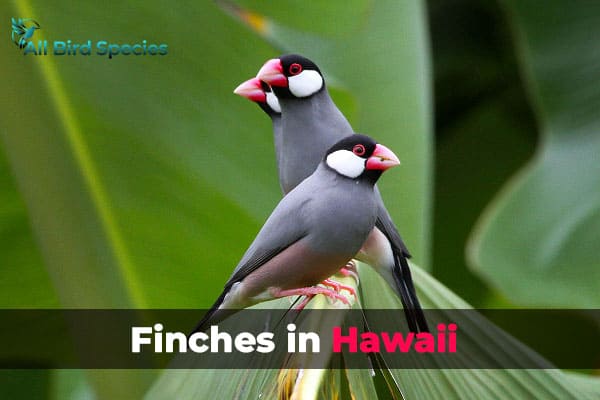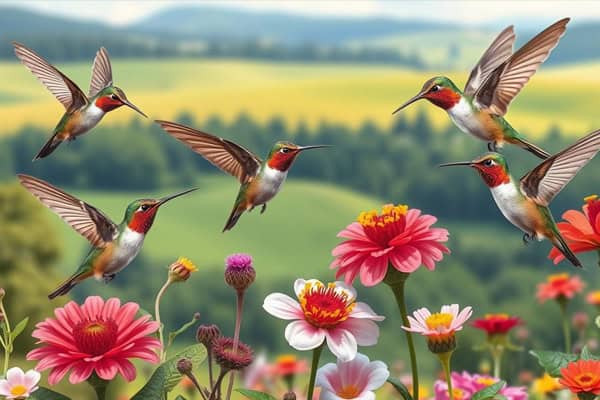Black Birds With Yellow Beaks (ID Guide With Pictures)
Did you know there are over 800 species of black birds with Yellow Beaks around the world? Many of these have beautiful yellow beaks. These birds grab our attention with their bright colors and interesting behaviors. They play a big role in our ecosystems.
As birdwatchers, we love the variety of black birds and what makes them special. This guide aims to deepen our knowledge of black birds with yellow beaks. It helps us enjoy and learn from these amazing birds in their natural settings.
Common Types of Black Birds With Yellow Beaks
Exploring black birds with yellow beaks reveals many interesting species. Each has unique features that help us identify them and understand their lives. Let’s look at some of the most notable birds with yellow beaks.
1. Common Blackbird
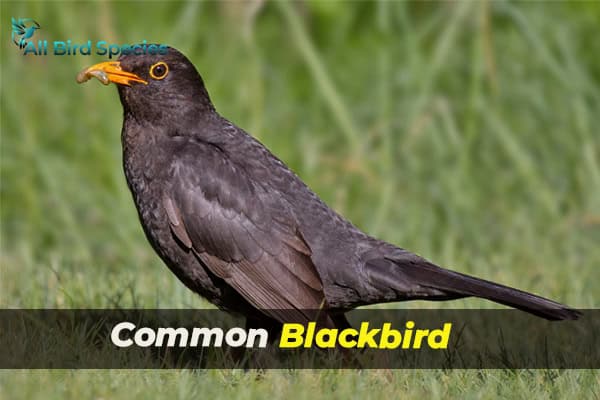
The Common Blackbird (Turdus merula) is easy to spot with its yellow-orange beak against black feathers. It’s common in gardens and parks, making it a city bird. Its song adds beauty to outdoor spaces, especially at dawn and dusk.
2. Common Myna
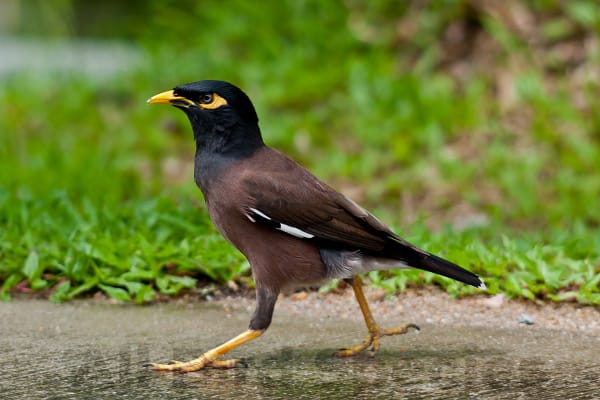
The Common Myna (Acridotheres tristis) thrives in places made by humans. It’s known for its yellow face and bright beak. This bird is loved for its lively nature and unique calls. It’s often seen looking for food in urban areas.
3. Yellow-billed magpie
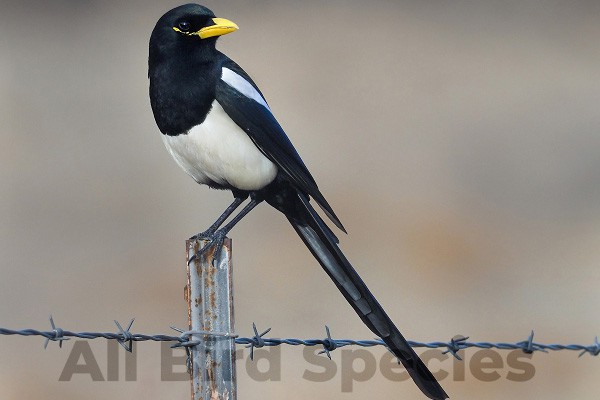
The Yellow-Billed Magpie (Pica nuttalli) is not all black but catches the eye with its yellow bill. It lives in California’s oak woodlands. This bird is social and often seen with friends, playing together.
| Species | Scientific Name | Distinguishing Features | Habitat |
|---|---|---|---|
| Common Blackbird | Turdus merula | Yellow-orange beak, glossy black plumage | Gardens, parks, urban areas |
| Common Myna | Acridotheres tristis | Yellow facial patches, yellow beak | Urban environments, scrublands |
| Yellow-Billed Magpie | Pica nuttalli | Yellow bill, black wings, social behavior | Oak woodlands in California |
Habitat Preferences of Black Birds With Yellow Beaks
Black birds with yellow beaks are adaptable and resilient. They live in both cities and nature, showing how they adjust to human changes. In cities, birds like the Common Blackbird live in parks and gardens, finding plenty of food and places to nest.
But, many still prefer natural places like wetlands, forests, and grasslands. These spots are key for their survival.
Urban vs. Natural Habitats
Urban areas have become new homes for black birds. They easily switch between different habitats, making them thrive in human spaces. Here’s a look at the differences between city and nature habitats:
| Habitat Type | Characteristics | Common Species |
|---|---|---|
| Urban | High human activity, parks, and gardens | Common Blackbird, Common Myna |
| Natural | Forests, wetlands, and grasslands | Yellow-Billed Magpie |
Migration Patterns and Seasonal Behavior
Many black birds with yellow beaks migrate to find better climates and food. The Common Blackbird moves to warmer places when it gets cold. Knowing about their migrations helps us understand their role in nature and appreciate their yearly travels.
Diet and Feeding Habits
Learning about the diet of black birds with yellow beaks helps us understand their role in nature. They eat a mix of insects, fruits, and seeds. This variety supports their life in cities and the wild, showing how they adapt to different places.
What Do They Eat?
Their diet changes with the seasons and their living space. They often eat:
- Insects like beetles, crickets, and caterpillars
- Fruits such as berries, apples, and cherries
- Seeds from various plants
This food gives them the nutrients they need to grow and reproduce. It shows how they can eat a wide variety of foods.
Foraging Techniques
Black birds with yellow beaks have interesting ways of finding food. The Common Blackbird often forages on the ground. This means they:
- Scratch the ground to find insects
- Use their sharp eyes to see fruits on the ground
- Peck at seeds on the ground
These methods help them survive in many places. It shows how smart they are and how they can live in different environments.
| Food Source | Foraging Technique | Habitat Performance |
|---|---|---|
| Insects | Ground foraging | Effective in rural areas |
| Fruits | Perching and pecking | Common in urban gardens |
| Seeds | Ground foraging and search | Widely available in meadows |
Breeding and Nesting Behavior
Learning about the breeding habits of black birds with yellow beaks is really interesting. They have unique ways during their breeding season. We’ll look at some key traits from different species.
Breeding Season Characteristics
The breeding season for these birds is in spring and early summer. Females build the nests, showing great skill with the materials they find. They try to reproduce at the best time to help their babies have a good chance of survival.
Nesting Locations and Structures
These birds pick their nesting spots carefully. They choose places like:
- Tree branches
- Dense shrubs
- Cliffs and ledges
Each place has its own challenges. Their cleverness helps them survive. The nests they make often match their environment, keeping their babies safe during reproduction.
Rare Species of Black Birds With Yellow Beaks
Exploring rare black birds with yellow beaks lets us see their unique traits and important roles in nature. We’ll look at the Toco Toucan and the Great Hornbill. They have special diets, live in certain places, and face challenges in the wild.
4. Toco Toucan
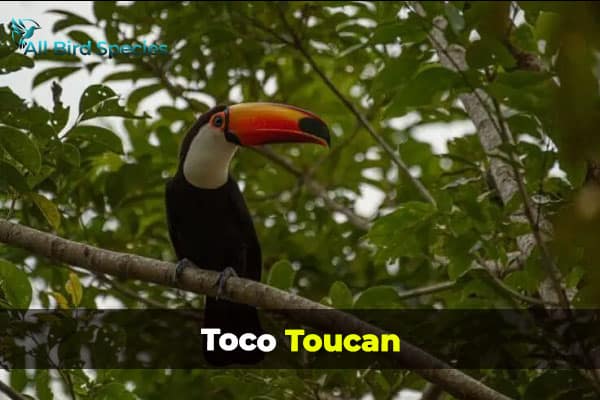
The Toco Toucan is big and colorful, standing out in the tropical parts of Central and South America. Bird lovers and photographers enjoy seeing it. Its bright yellow beak is key for eating and talking to others.
- Diet: It eats mostly fruits, seeds, and nuts, but sometimes insects too.
- Habitat: It likes forests with lots of fruit trees, which gives it plenty to eat.
- Conservation Status: It’s not endangered now, but losing its home to deforestation is a big worry.
5. Great Hornbill

The Great Hornbill is big and has a unique yellow beak. It lives mainly in South and Southeast Asia. This bird helps spread seeds in different trees.
- Diet: It eats fruits, small animals, and insects, depending on what’s around.
- Habitat: It prefers dense forests, especially in tropical and subtropical areas.
- Conservation Status: Hunting and losing its home are big threats, making its numbers go down in some places.
| Species | Diet | Habitat | Conservation Status |
|---|---|---|---|
| Toco Toucan | Fruits, seeds, insects | Tropical forests | Not endangered |
| Great Hornbill | Fruits, small animals, insects | Dense forests | Vulnerable |
Fun Facts About Black Birds With Yellow Beaks
Black birds with yellow beaks are full of surprises. They have vibrant social lives and colorful mating dances. Their unique behaviors and stories in folklore make them fascinating.
Interesting Behaviors
These birds show off their smarts and social skills with unique bird behaviors. Let’s look at some of their interesting habits:
- Mating Displays: Many species perform intricate dances to attract mates, featuring elaborate movements and vocalizations.
- Social Interactions: They engage in playful activities, often seen chasing each other around, which strengthens their social bonds.
- Tool Use: Some species have been observed using objects to obtain food, demonstrating remarkable problem-solving skills.
Mythology and Folklore
Across cultures, these birds are seen as more than just birds. They are woven into folklore, telling us about their importance. Here’s what folklore says about black birds with yellow beaks:
- Symbols of Knowledge: In many traditions, these birds are seen as messengers, symbolizing wisdom and knowledge.
- Guardians of the Sky: Cultures often depict them as protectors of the heavens, guarding against ill-fated events.
- Spirit Animals: They are considered spirit animals in several indigenous cultures, representing freedom and adaptability.
Photography and Birdwatching Tips
For those who love watching black birds with yellow beaks, using the right strategies can make the experience better. We can use birdwatching tips and photography techniques to capture the beauty of these birds. This way, we can enjoy their beauty without disturbing them.
Best Times to Observe
When it comes to birdwatching, timing is key. Black birds are usually more active at certain times of the day. This gives us a better chance to see them. Here are the best times to watch them:
- Early Morning: In the early morning, black birds are busy looking for food. The light is great for photos, making their colors stand out.
- Late Afternoon: As the day ends, black birds start to forage for food again. This is a good time to see their behaviors and take pictures.
- Seasonal Variation: Change your watching times with the seasons. Spring and early summer mean more food for them, so they’re easier to spot.
Keep these tips in mind to plan your birdwatching trips well. Taking photos during these best times will give you amazing shots. And, we’ll be able to watch black birds without disturbing them.
| Time of Day | Activity Level | Photography Benefits |
|---|---|---|
| Early Morning | High | Soft light for capturing detail |
| Late Afternoon | Moderate to High | Golden hour enhances appearance |
| All Day (Varies by Season) | Varies | Potential for unique behaviors |
Check Our Previous Articles:
| Hummingbirds in Illinois |
| White-necked Raven – Corvus albicollis |
| Woodpeckers in Maryland |
| Hawks in Maryland |
| Woodpeckers in Iowa |
Wrapping Up…
Black birds with yellow beaks are a fascinating part of our world. They add beauty to our surroundings and play important roles in their ecosystems. By learning about their habits and habitats, we gain valuable insights into birdwatching.
It’s crucial to protect these species because they face threats like habitat loss and human impact. We must work to preserve their homes. By spreading the word and helping with conservation, we can make sure future generations see these amazing birds.




